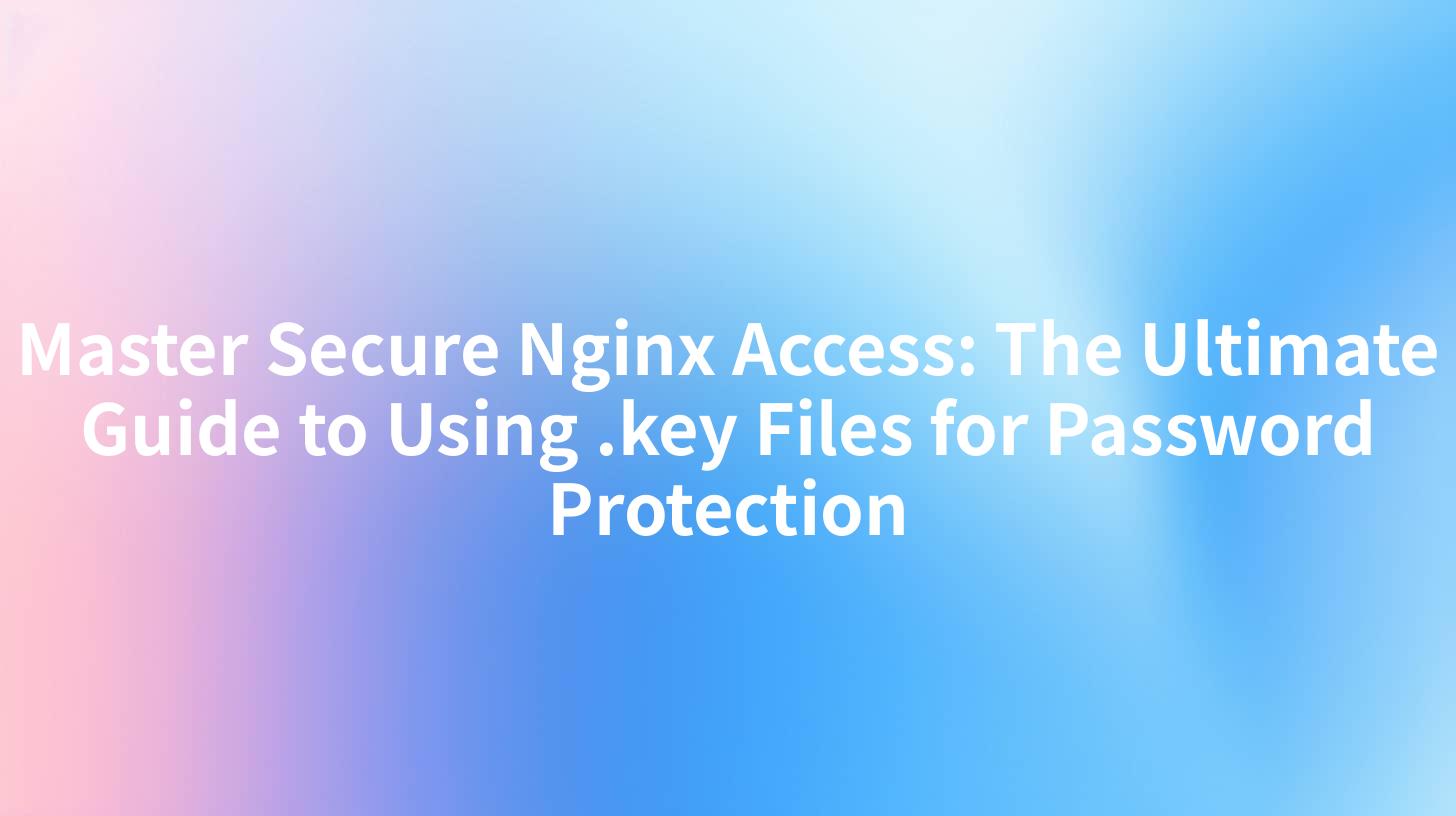Master Secure Nginx Access: The Ultimate Guide to Using .key Files for Password Protection

Introduction
In the world of web servers, Nginx stands out as a powerful and efficient solution for handling HTTP and mail traffic. Its flexibility and scalability make it a favorite among developers and system administrators. One of the key aspects of securing your Nginx server is implementing strong password protection. This guide will delve into the use of .key files for password protection in Nginx, offering a comprehensive understanding of the process and its benefits.
Understanding .key Files
What is a .key File?
A .key file, also known as a private key, is a file used to store cryptographic keys. These keys are used for various security purposes, including password protection in Nginx. When used in conjunction with .crt (certificate) files, .key files help to secure connections and prevent unauthorized access to your server.
Types of .key Files
There are different types of .key files, each serving a specific purpose:
- RSA Key: The most common type of key used for web servers.
- ECDSA Key: Offers better performance than RSA keys but is less commonly used.
- ED25519 Key: A newer type of key that is secure and efficient.
Setting Up Password Protection with .key Files
Generating a .key File
To start with, you need to generate a .key file. This can be done using OpenSSL, a widely-used tool for creating and managing cryptographic keys and certificates.
openssl genrsa -out yourdomain.key 2048
This command generates a 2048-bit RSA key and saves it as yourdomain.key.
Creating a .crt File
Next, you need to create a .crt file, which is the public key counterpart to your .key file. This file will be used by Nginx to verify the identity of the server.
openssl req -new -key yourdomain.key -out yourdomain.csr
This command generates a Certificate Signing Request (CSR) file, which is used to obtain a certificate from a Certificate Authority (CA).
Obtaining a Certificate
Once you have the CSR file, you can submit it to a CA to obtain a certificate. The CA will verify your domain ownership and issue a certificate.
Configuring Nginx
Now that you have your .key and .crt files, you need to configure Nginx to use them for password protection.
- Create a Password File: Generate a password file using
htpasswd:
htpasswd -c /etc/nginx/.htpasswd username
- Configure Nginx: Modify your Nginx configuration file to include the
.keyand.crtfiles:
server {
listen 443 ssl;
server_name yourdomain.com;
ssl_certificate /etc/nginx/yourdomain.crt;
ssl_certificate_key /etc/nginx/yourdomain.key;
ssl_session_timeout 1d;
ssl_session_cache shared:SSL:50m;
ssl_session_tickets off;
ssl_protocols TLSv1.2 TLSv1.3;
ssl_ciphers 'ECDHE-ECDSA-AES128-GCM-SHA256:ECDHE-RSA-AES128-GCM-SHA256:ECDHE-ECDSA-AES256-GCM-SHA384:ECDHE-RSA-AES256-GCM-SHA384:DHE-RSA-AES128-GCM-SHA256:DHE-RSA-AES256-GCM-SHA384';
ssl_prefer_server_ciphers on;
location / {
auth_basic "Protected Area";
auth_basic_user_file /etc/nginx/.htpasswd;
try_files $uri $uri/ =404;
}
}
- Restart Nginx: Apply the changes by restarting Nginx:
sudo systemctl restart nginx
APIPark is a high-performance AI gateway that allows you to securely access the most comprehensive LLM APIs globally on the APIPark platform, including OpenAI, Anthropic, Mistral, Llama2, Google Gemini, and more.Try APIPark now! 👇👇👇
Benefits of Using .key Files
Enhanced Security
Using .key files for password protection adds an extra layer of security to your Nginx server. It ensures that only authorized users can access sensitive information.
Flexibility
.key files can be used in various scenarios, such as securing access to specific directories or files on your server.
Cost-Effective
Generating and using .key files is a cost-effective way to secure your Nginx server without relying on third-party services.
Conclusion
In this guide, we have explored the process of using .key files for password protection in Nginx. By following the steps outlined above, you can enhance the security of your server and protect sensitive information from unauthorized access.
Table: Key Steps in Using .key Files for Password Protection
| Step | Description |
|---|---|
| 1 | Generate a .key file using OpenSSL. |
| 2 | Create a .crt file using OpenSSL. |
| 3 | Obtain a certificate from a Certificate Authority. |
| 4 | Configure Nginx to use the .key and .crt files. |
| 5 | Restart Nginx to apply the changes. |
Frequently Asked Questions (FAQ)
Q1: Can I use a .key file for password protection in Nginx without a certificate? A1: No, a .key file alone is not sufficient for password protection in Nginx. You need to pair it with a .crt file (certificate) to establish a secure connection.
Q2: How do I know if my .key file is secure? A2: Ensure that your .key file is kept private and is not accessible to unauthorized users. Use strong encryption algorithms and regularly update your keys.
Q3: Can I use a .key file for password protection in both HTTP and HTTPS? A3: No, .key files are primarily used for HTTPS (secure HTTP) connections. They are not suitable for plain HTTP.
Q4: How do I update my .key file? A4: To update your .key file, generate a new one and replace the old file. Ensure that you also update your .crt file and certificate if necessary.
Q5: Can I use a .key file for password protection in other web servers? A5: Yes, .key files can be used for password protection in various web servers, including Apache and IIS, as long as the server supports SSL/TLS.
🚀You can securely and efficiently call the OpenAI API on APIPark in just two steps:
Step 1: Deploy the APIPark AI gateway in 5 minutes.
APIPark is developed based on Golang, offering strong product performance and low development and maintenance costs. You can deploy APIPark with a single command line.
curl -sSO https://download.apipark.com/install/quick-start.sh; bash quick-start.sh

In my experience, you can see the successful deployment interface within 5 to 10 minutes. Then, you can log in to APIPark using your account.

Step 2: Call the OpenAI API.


